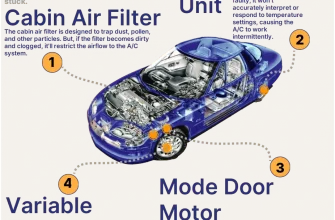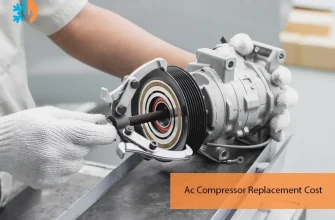The timing belt is a crucial component of your vehicle’s engine, playing a vital role in ensuring that the engine’s valves and pistons work in perfect harmony․ Over time, this rubber belt can wear out, leading to potential engine damage if not replaced in a timely manner․ In this guide, we will walk you through the key steps and considerations for replacing your engine’s timing belt․
- Understanding the Timing Belt
- Signs That Your Timing Belt Needs Replacement
- Tools and Materials Needed
- Step-by-Step Timing Belt Replacement
- Step 1: Prepare the Vehicle
- Step 2: Remove Components
- Step 3: Align Timing Marks
- Step 4: Remove the Old Timing Belt
- Step 5: Install the New Timing Belt
- Step 6: Reassemble and Test
- Additional Considerations for Timing Belt Replacement
- 1․ Inspect Associated Components
- 2․ Use Quality Parts
- 3․ Follow Manufacturer Guidelines
- 4․ Consider Professional Assistance
- Post-Replacement Care
Understanding the Timing Belt
The timing belt synchronizes the rotation of the crankshaft and camshaft, allowing for proper timing of the engine’s valves․ Typically made from reinforced rubber, the timing belt is designed to withstand significant stress and friction․ However, like all parts, it has a finite lifespan, generally ranging from 60,000 to 100,000 miles depending on the make and model of your vehicle;
Signs That Your Timing Belt Needs Replacement
- Engine Misfiring: If the timing belt is worn or damaged, it can cause the engine to misfire․
- Unusual Engine Noises: A ticking sound from the engine can indicate that the timing belt is failing․
- Oil Leaks: A timing belt that is wearing out may lead to oil leaks around the engine․
- Check Engine Light: If your check engine light illuminates, it may be related to the timing belt․
Tools and Materials Needed
Before starting the replacement process, ensure you have the following tools and materials:
- Socket wrench set
- Screwdrivers
- Torque wrench
- New timing belt
- Tensioner and idler pulleys (if applicable)
- Engine oil
- Gasket sealant
Step-by-Step Timing Belt Replacement
Step 1: Prepare the Vehicle
Ensure the vehicle is parked on a level surface, and disconnect the negative battery terminal to prevent any electrical issues․
Step 2: Remove Components
Depending on your vehicle, you may need to remove components such as the engine covers, accessories belts, and possibly the water pump to access the timing belt․
Step 3: Align Timing Marks
Before removing the old timing belt, align the timing marks on the crankshaft and camshaft to ensure proper installation of the new belt․
Step 4: Remove the Old Timing Belt
Loosen the tensioner and remove the old timing belt carefully․ Take note of the routing of the belt for reference․
Step 5: Install the New Timing Belt
Position the new timing belt according to the manufacturer’s specifications, ensuring it is tight but not overly stretched․ Reinstall the tensioner and idler pulleys if necessary․
Step 6: Reassemble and Test
Reinstall all components that were removed, ensuring everything is secured correctly․ Reconnect the battery and start the engine to test for smooth operation․ Listen for any unusual noises․
Replacing your engine’s timing belt can seem daunting, but with the right tools and a bit of patience, it can be accomplished successfully․ Regular maintenance and timely replacement of the timing belt are essential to ensure the longevity and performance of your engine․ Always consult your vehicle’s manual for specific instructions related to your model․
Remember, if you feel unsure about any step in this process, it’s always best to consult with a professional mechanic․
Additional Considerations for Timing Belt Replacement
While the timing belt replacement process can be straightforward, there are several additional considerations that can ensure a successful repair and enhance the longevity of your engine․
1․ Inspect Associated Components
When replacing the timing belt, it’s wise to inspect associated components such as the water pump, tensioners, and idler pulleys․ If these parts show signs of wear, replacing them during the timing belt service can save you time and money in the long run․ A failed water pump, for instance, can lead to overheating, which could damage your engine․
2․ Use Quality Parts
Investing in high-quality replacement parts is crucial․ OEM (Original Equipment Manufacturer) parts are often recommended as they are designed specifically for your vehicle model․ While aftermarket parts can be more affordable, ensure they meet or exceed OEM specifications to avoid premature failure․
3․ Follow Manufacturer Guidelines
Every vehicle comes with a specific set of guidelines regarding the timing belt replacement interval and procedure․ Always refer to your vehicle’s service manual for the manufacturer’s recommendations․ Adhering to these guidelines ensures that you are following the best practices for your particular engine․
4․ Consider Professional Assistance
If you’re not entirely confident in your mechanical skills or if your vehicle has a particularly complex timing belt system, consider seeking help from a professional mechanic․ A trained technician can ensure that the job is done correctly and safely, potentially saving you from costly mistakes․
Post-Replacement Care
After replacing the timing belt, there are a few steps you can take to ensure everything runs smoothly:
- Check for Leaks: After the installation, monitor the engine for any signs of oil or coolant leaks․ Catching leaks early can prevent more serious issues later․
- Listen for Noises: During the first few drives after replacement, pay attention to any unusual sounds․ If you hear a ticking or grinding noise, it may indicate that the belt is improperly installed or that another component is malfunctioning․
- Keep Records: Document the replacement date and mileage for your records․ This information will help you remember when your next replacement is due and can be useful for future maintenance or resale of the vehicle․
Replacing your timing belt is an essential maintenance task that can prevent significant engine damage and costly repairs․ By understanding the signs of wear, following the correct procedures, and considering the associated components, you can ensure a successful timing belt replacement․ Regular maintenance, along with timely replacement, is key to keeping your engine running smoothly and efficiently․ Whether you decide to tackle the job yourself or seek professional help, being informed will empower you to make the best decision for your vehicle’s health․
Remember, the timing belt may be out of sight, but it should never be out of mind!









This article provides a comprehensive guide on timing belt replacement. It’s detailed and easy to understand, making it perfect for beginners!
I appreciated the clear breakdown of signs that indicate a timing belt needs replacement. It helped me identify issues with my car!
I never realized how important the timing belt is until now. This article really opened my eyes to its role in engine performance!
The step-by-step instructions are very helpful. I feel more confident tackling this project on my own after reading this guide.
I found this guide extremely informative. The tips on what to look for when diagnosing problems with the timing belt were invaluable!
Great information! The section about tools and materials needed was particularly useful for someone like me who is new to car maintenance.
Fantastic article! The explanations are clear and concise, making it easy for anyone to understand the importance of timely replacement.